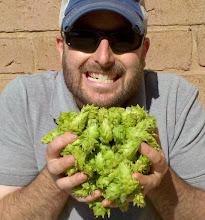Today's the first day I've touched the farm since December (routine weeding). You can see that some of last year's vines are still intact. We had a very wet winter here in southern California and the growth really shows. We really wanted to clear the weeds, remove last year's vines, rewire each mound, level each terrace, split the top row rhizomes for the bottom row, prune the mounds, fertilize, and mulch. That didn't all happen.
 The weeds alone kept us busy along with rewiring the trellis. I could see lots of other seeds in the soil so this spring will be an ongoing battle. Luckily, there's a huge mound of mulch above the top row. This helps keeps the weeds down while holding in moisture and providing good soil.
The weeds alone kept us busy along with rewiring the trellis. I could see lots of other seeds in the soil so this spring will be an ongoing battle. Luckily, there's a huge mound of mulch above the top row. This helps keeps the weeds down while holding in moisture and providing good soil. With all the rain we've had this season and the consistent movement of the mulch pile, the terrace levels are more of slant. This makes it difficult to use the ladder now and during harvest time. Instead of plowing through, we had to be careful of the irrigation line and the hops that have recently greeted spring.
With all the rain we've had this season and the consistent movement of the mulch pile, the terrace levels are more of slant. This makes it difficult to use the ladder now and during harvest time. Instead of plowing through, we had to be careful of the irrigation line and the hops that have recently greeted spring. We removed all of the old vines and decided to replace the wire. Each wire is grounded by a rebar stake. Using the old wire as a guide, we dug to the rebar stake loop and wrapped new wire rather than pulling out every stake.
We removed all of the old vines and decided to replace the wire. Each wire is grounded by a rebar stake. Using the old wire as a guide, we dug to the rebar stake loop and wrapped new wire rather than pulling out every stake. Once all the weeds were cleared, you can see the hops are already taking off. On the top row, there are 5 mounds each of Chinook and Centennial (separated by a pole in the middle). In the middle row are 5 mounds each of Vojvodina and Magnum. The bottom row has spent two years trying to establish Tettnanger and Cascade without any significant growth. Since the Chinook and Centennial do exceptionally well, this year the top row rhizomes will be split and planted in the bottom row.
Once all the weeds were cleared, you can see the hops are already taking off. On the top row, there are 5 mounds each of Chinook and Centennial (separated by a pole in the middle). In the middle row are 5 mounds each of Vojvodina and Magnum. The bottom row has spent two years trying to establish Tettnanger and Cascade without any significant growth. Since the Chinook and Centennial do exceptionally well, this year the top row rhizomes will be split and planted in the bottom row. Above is the top row, the Chinook half. We have a bit of work to do this coming weekend: splitting, planting, pruning, fertilizing, and mulching.
Above is the top row, the Chinook half. We have a bit of work to do this coming weekend: splitting, planting, pruning, fertilizing, and mulching.






If I didn't know where this place was .. from the pictures I swear it could be the hop hills of Italy or some other really really cool place
ReplyDeletehey sean,
ReplyDeletei also have a established hop yard and growing in Central Coast California. What type of variates are you growing in that hot of weather?
email me back at
sean_mccaffrey@live.com
I would imagine that many hop varieties would do very well in Central Coast. The area where I grow my hops is very hot and dry during the summer. I currently grow four: Chinook, Centennial, Magnum, and Vojvodina. I'm not sure how much room you have and the number of varieties you would like to grow. I find that Chinook does extremely well in my conditions. Centennial also does well but typically has only one full harvest. Magnum does well but has a lower yield, same with the Voj. I've also tried Goldings and Cascade but natural selections (ie rabbits) eliminated these quickly.
ReplyDeleteI would suggest picking a couple of varieties you really like and giving them a try. You may as well grow what you'll enjoy using. I've heard that the first season can be minimal for many varieties but I haven't experienced this. With proper watering, planting in mounds, and good fertilization, you can expect decent yield even during your first yield. Hops love lots of sun. Don't worry too much about the heat, they seem to manage well.